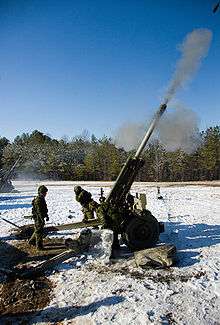M101 howitzer
| M101A1 105 mm Howitzer | |
|---|---|
|
U.S. Marines fire a M101A1 howitzer during a ceremony in 2005 | |
| Type | Howitzer |
| Place of origin | United States |
| Service history | |
| Used by |
|
| Wars |
World War II Korean War First Indochina War Vietnam War Insurgency in the Philippines |
| Production history | |
| Manufacturer | Rock Island Arsenal |
| Produced | 1941–1953 |
| Specifications | |
| Weight | 2,260 kg (4,980 lb) |
| Length | 5.94 m (19 ft 6 in) |
| Barrel length | 2.31 m (7 ft 7 in) L/22 |
| Width | 2.21 m (7 ft 3 in) |
| Height | 1.73 m (5 ft 8 in) |
|
| |
| Shell | 105x372R |
| Caliber | 105 mm (4.1 in) |
| Breech | horizontal block |
| Recoil | hydropneumatic, constant, 42 in (110 cm) |
| Carriage | split trail |
| Elevation | -5° to +66° |
| Traverse | 46° |
| Muzzle velocity | 472 m/s (1,550 ft/s) |
| Maximum firing range | 11,270 m (7.00 mi) |
The 105 mm M2A1 (M101A1) howitzer was a howitzer developed and used by the United States. It was the standard U.S. light field howitzer in World War II and saw action in both the European and Pacific theaters. Entering production in 1941, it quickly gained a reputation for accuracy and a powerful punch. The M101A1 fired 105-millimetre (4.1 in) high explosive (HE) semi-fixed ammunition and had a range of 11,270 metres (12,330 yd), making it suitable for supporting infantry.
All of these qualities of the weapon, along with its widespread production, led to its adoption by many countries after the war. Its ammunition type also became the standard for many foreign countries' later models.
History
During the Second World War, U.S. artillery regiments consisted of an HQ detachment, one 155mm artillery battalion, and three 105mm artillery battalions. Both the 155mm and 105mm battalions had twelve guns each, divided into three batteries of four guns. That gave each regiment a total of twelve 155mm howitzers, and thirty six 105mm howitzers. [1] With an HE M1 shell fired at 9000 meters, the probable error in range was 41 meters, while the probable error in line was 10 meters.
The U.S. military artillery designation system was changed in 1962, redesignating the 105mm M2A1 howitzer the M101A1. The gun continued to see service in the Korean and Vietnam Wars. Though a similar model, the M102 howitzer, shared the same roles in battle, it never fully replaced the M101A1. Today, the M101A1 has been retired by the U.S. military, though it continues to see service with many other countries. By the end of the Second World War, 8,536 105mm towed howitzers had been built and post-war production continued at Rock Island Arsenal until 1953, by which time 10,202 had been built.
The Canadian Forces continued to use the M2A1 as the C2 Howitzer until 1997, when a modification was made to extend its service life; it is now designated the C3. The changes include a longer barrel, a muzzle brake, reinforced trails and the removal of shield flaps. It remains the standard light howitzer of Canadian Forces Reserve units. The C3 is used by Reserve units in Glacier National Park in British Columbia as a means of avalanche control. In addition, the M101 has found a second use in the U.S. as an avalanche control gun, supervised by the US Forest Service.
France and the State of Vietnam used M2A1 howitzers during the First Indochina War, as did the Viet Minh guerilla forces, who were supplied with at least 24 by the People's Republic of China, along with other captured American artillery pieces and mortars formerly operated by the Nationalist Chinese forces (the Kuomintang military). Today upgraded M2A1 howitzers (some of which have been mounted on trucks and employed as self-propelled artillery) are still being used by the People's Army of Vietnam (the VPA). It continues to remain as the primary tactical field-howitzer of the VPA.[2][3]
A number of M2/M101 howitzers were used by the Socialist Federal Republic of Yugoslavia and approximately 50 were inherited by Croatia, of which four are still in use for training with the Croatian army.
M2 Howitzers are still in limited service in the Australian Army Reserve, but are being replaced with 81-millimetre (3.2 in) mortars with an emphasis on the retention of indirect fire support skills.[4] In regular service they were replaced by the 105mm L119 Hamel gun and the 155-millimetre (6.1 in) M198 howitzers.
Two M2 howitzers (1942) are still employed in providing the gun salute at Kristiansten Fortress, in Trondheim, Norway. M101/M2 is one of three approved salute guns in the Norwegian armed forces, and have been reduced to a caliber of 75 millimetres (3.0 in) for this purpose. They are used for gun salute also at Rena and Setermoen.
Variants


Gun variants:
- M1920 - prototype.[5]
- M1925E - prototype.[5]
- T2 prototype, standardized as M1.[5]
- M2 (1934) - minor changes to the chamber to allow use of fixed ammunition.[5]
- M2A1 (1940) - modified breech ring.[6]
- M3 - lightweight howitzer, with barrel shortened by 27 inches.
- T8 prototype (standardized as 105mm M4 Howitzer in September, 1943) - vehicle-mounted variant with modified breech and with cylindrical recoil surface.[7]:210
- M101 - post-war designation of M2A1 on carriage M2A1
- M101A1 - post-war designation of M2A1 on carriage M2A2
- C3 - Canadian C1 (M2A1) with lengthened, 33-caliber barrel
Carriage variants:
- M1920E - prototype, split trail.[5]
- M1921E - prototype, box trail.[5]
- M1925E - prototype, box trail.[5]
- T2, standardized as M1 - split trail, wooden wheels.[5]
- M1A1 - M1 carriages rebuilt with new wheels, brakes and other parts.[6]
- T3 - prototype.[5]
- T4 - prototype.[5]
- T5, standardized as M2 (1940) - split trail, steel wheels with pneumatic tires.[5]
- M2A1 - electric brakes removed.[8]
- M2A2 - modified shield.[8]
- XM124 & XM124E1 Light Auxiliary Propelled Howitzer - prototype (1962-1965) - produced by Sundstrand Aviation Corporation, who added an auxiliary drive system for local maneuverability (See also similar XM123 Medium Auxiliary Propelled 155mm Howitzer with similar configuration). The base XM124 provided two 20 horsepower, air-cooled engines, while the XM124E1 provided a single 20 horsepower engine and electric steering.
- M2A2 Terra Star Auxiliary Propelled Howitzer - prototype (1969-1977) - Lockheed Aircraft Service Company added an auxiliary drive system and a tri-star wheel system to the carriage of an M2A2 105mm Light Howitzer to provide local maneuverability. The last surviving example is at the Rock Island Arsenal Museum.

Self-propelled mounts
- Medium Tank M4A4E1 - M2A1 in mount T70.[7]:568
- Medium Tank M4(105), M4A3(105) - M4 in mount M52.[7]:568
- Medium/Heavy Tank M45 - M4 in mount M71.[9]:233
- Experimental mount on Holt tractor - M1920.[10]:317
- Experimental chassis designed by J Walter Christie - M1920.[10]:317
- 105mm Howitzer Motor Carriage T9 (based on Cletrac MG-2 tractor).[10]:329
- 105mm Howitzer Motor Carriage T19 (based on M3 halftrack) - M2A1.[11]:236
- 105mm Howitzer Motor Carriage T32 / M7 - M2A1.[7]:568
- 105mm Howitzer Motor Carriage T76 / M37 (Light Tank M24 chassis) - M4 in mount M5.[10]:329
- 105mm Howitzer Motor Carriage T88 (76mm GMC M18 chassis) - M4 in mount M20.[10]:334
- M56 105mm similar to the M101 made in ex Yugoslavia and still made in Bosnia
- EVO-105 105mm howitzer mounted on an armored 5-ton truck system built by Samsung Techwin for the Republic of Korea Army
- Vietnamese M101 howitzer mounted on an Ural-375D 6x6 truck[12]
Ammunition
The gun fired semi-fixed ammunition, with 105mm Cartridge Case M14. The propelling charge consisted of a base charge and six increments, forming seven charges from 1 (the smallest) to 7 (the largest). Use of M1 HE rounds prepared for the 105mm howitzer M3 (same projectile and cartridge, but different propelling charge) was authorized.[13]
HEAT M67 Shell was originally designed as fixed round, with Cartridge Case M14 type II. It was later changed to semi-fixed type with the standard cartridge, but with non-adjustable propelling charge. For blank ammunition, a shorter Cartridge Case M15 with black powder charge was used.[13]
| Available ammunition[11]:236[13][14] | |||||
| Type | Model | Weight, kg (round/projectile) | Filler | Muzzle velocity, m/s | Range, m |
| HE | HE M1 Shell | 19.08 / 14.97 | TNT or 50/50 amatol, 2.18 kg | 472 | 11,160 |
| HEAT-T | HEAT M67 Shell | 16.71 / 13.25 | Pentolite, 1.33 kg | 381 | 7,854 |
| Smoke | HC BE M84 Shell | 19.02 / 14.91 | Zinc chloride (HC) | 472 | 11,160 |
| Smoke, colored | BE M84 Shell | 17.86-18.04 / | Smoke mixture | ||
| Smoke | WP M60 Shell | 19.85 / 15.56 | White Phosphorus (WP), 1.84 kg | 472 | 11,110 |
| Smoke | FS M60 Shell | 20.09 / | Sulfur trioxide in Chlorosulfonic acid, 2.09 kg | ||
| Chemical | H M60 Shell | 19.43 / | Mustard gas, 1.44 kg | ||
| Practice | Empty M1 Shell | 472 | 11,160 | ||
| Drill | Drill Cartridge M14 | - | - | ||
| Blank | - | - | |||
| Armor penetration, mm[11]:236 | ||||
| Ammunition \ Distance, m | 0 | 457 | 914 | 1,828 |
| HEAT M67 Shell (meet angle 0°) | 102 | |||
| Concrete penetration, mm[11]:236 | ||||
| HE M1 Shell (meet angle 0°) | 457 | 427 | 396 | 335 |
| Different methods of measurement were used in different countries / periods. Therefore, direct comparison is often impossible. | ||||
Operators

-
 Argentina
Argentina -
 Australia
Australia -
 Austria
Austria -
 Bahrain
Bahrain -
 Bangladesh
Bangladesh -
.svg.png) Belgium
Belgium -
 Benin
Benin -
 Bosnia and Herzegovina
Bosnia and Herzegovina -
 Brazil
Brazil -
 Burkina Faso
Burkina Faso -
 Cameroon
Cameroon -
 Canada Designated C3 - Canadian C1 (M2A1) with lengthened, 33-caliber barrel
Canada Designated C3 - Canadian C1 (M2A1) with lengthened, 33-caliber barrel -
 Chile
Chile -
 Republic of China
Republic of China -
 Colombia
Colombia -
 Croatia
Croatia -
 Dominican Republic
Dominican Republic -
 Ecuador
Ecuador -
 El Salvador
El Salvador -
 France
France -
 Germany
Germany -
 Greece
Greece -
 Guatemala
Guatemala -
 Honduras
Honduras -
 India
India -
 Indonesia
Indonesia -
 Iran
Iran -
 Iraq
Iraq -
 Japan
Japan -
 South Korea
South Korea  Khmer Republic
Khmer Republic-
 Lebanon
Lebanon -
 Lithuania
Lithuania -
 Macedonia
Macedonia -
 Malaysia
Malaysia -
 Mexico
Mexico -
 Morocco
Morocco -
 Myanmar
Myanmar -
 New Zealand
New Zealand -
 Nicaragua
Nicaragua -
 Norway
Norway -
 Pakistan
Pakistan -
 Paraguay
Paraguay -
 Peru
Peru -
 Philippines
Philippines -
 Portugal
Portugal -
 Rhodesia[15]
Rhodesia[15] -
 Senegal
Senegal -
 South Africa[16]
South Africa[16] -
 Thailand
Thailand -
 Togo
Togo -
 Turkey
Turkey -
 United States
United States -
 Uruguay
Uruguay -
 Venezuela
Venezuela -
 Vietnam [2][3]
Vietnam [2][3]
See also
- List of U.S. Army weapons by supply catalog designation (SNL C-21)
- List of U.S. Army munitions by supply catalog designation (Semi-Fixed Ammunition for 105mm M2, M2A1, and M4 Howitzer) (AIC R1Q or R1U)
- L118 Light Gun - Lightweight 105 mm howitzer designed in the 1970s
- LG1 - Modern lightweight 105 mm howitzer
- G7 - Modern 105 mm howitzer
Notes
- ↑ http://www.history.army.mil/html/books/OH_of_FA/CMH_60-16-1.pdf McKenney, Janice E (2007). The Organizational History of Field Artillery, 1775–2003 (CMH Pub 60-16). Army Lineage Series. Washington: Center of Military History. pp 146.
- 1 2 "M2A1 105mm light field howitzer on the way to base, after a live firing exercise.". March 31, 2014.
- 1 2 "M2A1 howitzer on the way to firing ground". March 25, 2014.
- ↑ Toohill, MAJ Ian (August 2009). "Mortars for Reserve Gunners" (PDF). 2nd Division, Army Reserves Public Affairs. The Bayonet. p. 10. Retrieved 6 January 2012.
- 1 2 3 4 5 6 7 8 9 10 11 Hogg - Allied Artillery of World War Two, p 42-49.
- 1 2 Technical Manual TM 9-2005 volume 3, Infantry and Cavalry Accompanying Weapons.
- 1 2 3 4 Hunnicutt - Sherman: A History of the American Medium Tank
- 1 2 Technical Manual TM 9-1325, 105mm Howitzers M2 and M2A1; Carriages M2A1 and M2A2; and Combat Vehicle Mounts M3 and M4.
- ↑ Hunnicutt - Pershing: A History of the Medium Tank T20 Series
- 1 2 3 4 5 Hunnicutt - Stuart: A History of the American Light Tank
- 1 2 3 4 Hunnicutt - Half-Track: A History of American Semi-Tracked Vehicles
- ↑ Vietnam Has Developed a 105mm Self-Propelled Howitzer on a Ural-375D Chassis
- 1 2 3 Technical Manual TM 9-1901, Artillery Ammunition, p 167-178.
- ↑ Technical Manual TM 9-1904, Ammunition Inspection Guide, p 471-484.
- ↑ John Keegan, page 589 World Armies, ISBN 0-333-17236-1
- ↑ G6 L45 self-propelled towed gun-howitzer
References
- Hogg, Ian V. (1998). Allied Artillery of World War Two. Crowood Press, Ramsbury. ISBN 1-86126-165-9.
- Hunnicutt, R. P. (1971). Pershing: A History of the Medium Tank T20 Series. Feist Publications.
- Hunnicutt, R. P. (1992). Stuart: A History of the American Light Tank. Presidio Press. ISBN 0-89141-462-2.
- Hunnicutt, R. P. (1994). Sherman: A History of the American Medium Tank. Presidio Press. ISBN 0-89141-080-5.
- Hunnicutt, R. P. (2001). Half-Track: A History of American Semi-Tracked Vehicles. Presidio Press. ISBN 0-89141-742-7.
- Technical Manual TM 9-1325, 105mm Howitzers M2 and M2A1; Carriages M2A1 and M2A2; and Combat Vehicle Mounts M3 and M4. War Department, 1944.
- Technical Manual TM 9-1901, Artillery Ammunition. War Department, 1944.
- Technical Manual TM 9-1904, Ammunition Inspection Guide. War Department, 1944.
- Technical Manual TM 9-2005 volume 3, Infantry and Cavalry Accompanying Weapons. War Department, 1942.
External links
| Wikimedia Commons has media related to M101 105 mm howitzer. |
- Two Guns For One, November 1942, Popular Science one of the earliest detailed public article published on the M101 Howitzer
- FAS Military Analysis Network
